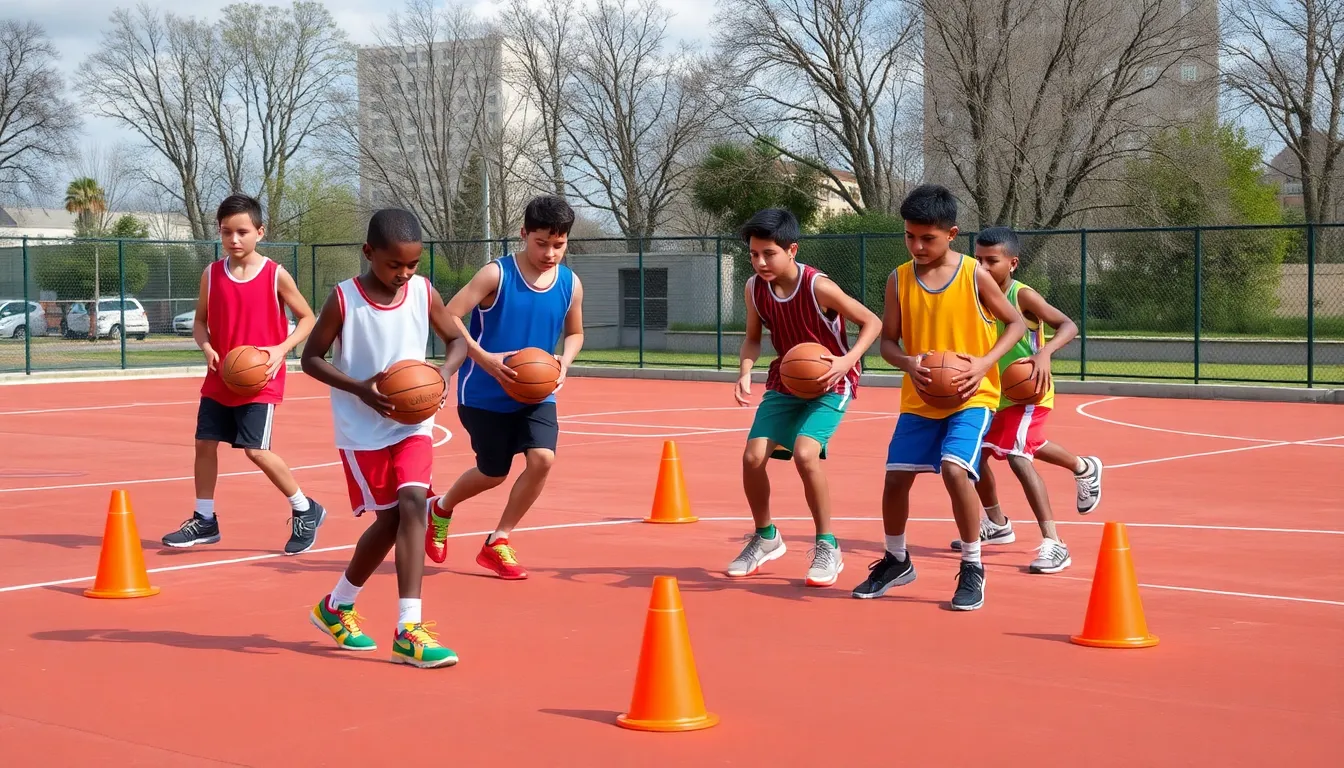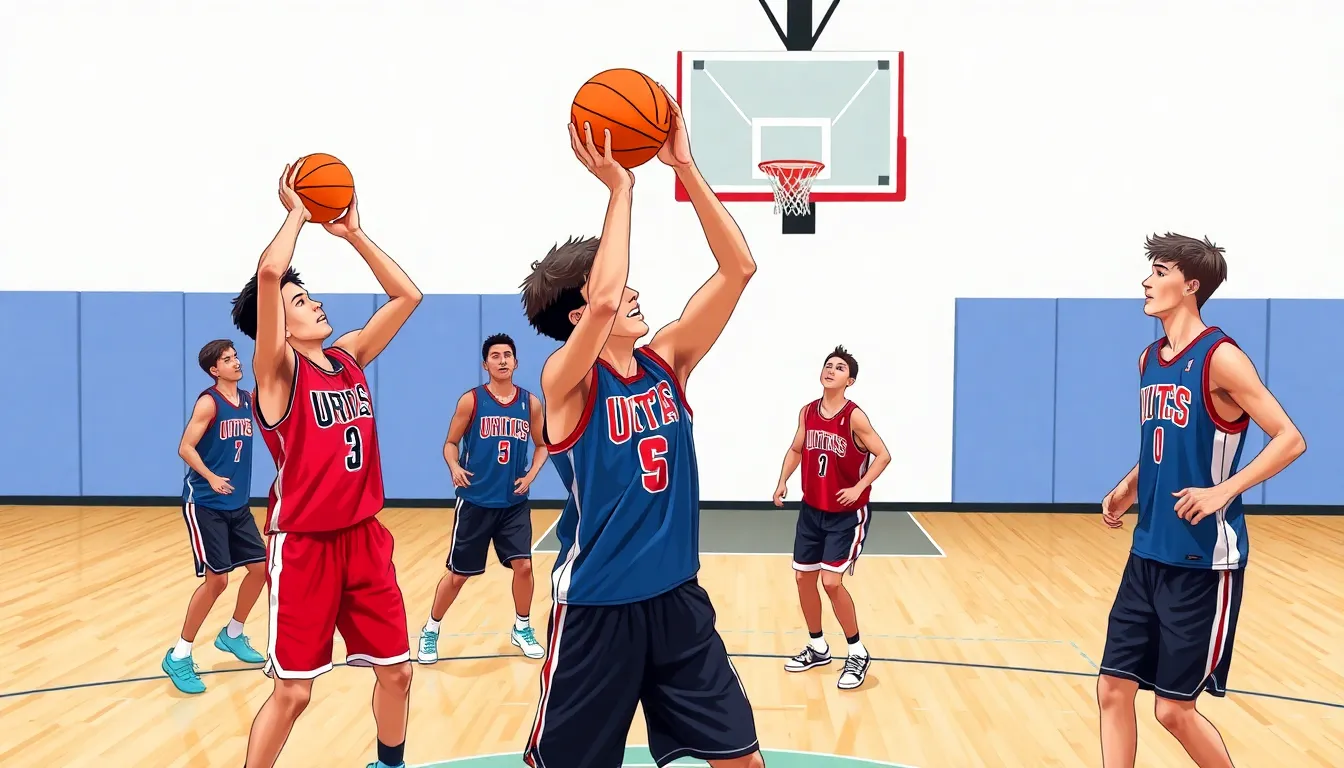Basketball isn’t just a game; it’s an art form, and like any artist, players need to practice their craft. Whether you’re dreaming of slam dunks or perfecting your three-point shot, the right practice drills can turn those dreams into reality. Picture this: you, sinking baskets like a pro while your friends are still struggling to find their rhythm. Sounds appealing, right?
Basketball Practice Drills
Improving skills in basketball requires dedicated practice drills. These drills enhance fundamental abilities, such as shooting, dribbling, and passing. Players often notice significant improvements in their game after consistent practice sessions.
Mastering specific techniques contributes to effective gameplay, allowing players to handle high-pressure situations with confidence. Engaging in practice drills develops muscle memory, which enhances performance during actual games. Practicing drills in game-like scenarios prepares players for the dynamics of competition.
Practicing with peers promotes teamwork and communication. Drills that involve multiple players foster collaboration, helping teams to develop chemistry. Focusing on specific areas, such as defense or shooting accuracy, leads to targeted improvements.
Implementing a structured practice routine ensures players remain engaged and motivated. Consistently working on established drills prevents stagnation and fosters continuous growth. With the right drills, players can analyze their strengths and weaknesses, leading to more focused training sessions.
Participants in these drills build confidence over time, which translates to better on-court decision-making. Regular practice not only enhances individual skills but also elevates overall team performance. Coaches play a vital role in selecting and adapting drills to address players’ unique needs, ensuring a well-rounded skill set.
Prioritizing practice drills forms a foundation for basketball success, promoting both personal growth and team dynamics.
Types Of Basketball Practice Drills

Effective basketball practice includes various drills that target specific skills. These drills can enhance players’ abilities and contribute to overall team performance.
Dribbling Drills
Dribbling drills emphasize ball control and agility. Players can use cone drills to navigate through a set pattern, improving their ability to handle the ball under pressure. Another option is the two-ball dribbling drill, where players maneuver two basketballs simultaneously to enhance coordination. Variations of these drills can include speed dribbling, which focuses on quick changes of direction. Practicing these techniques consistently builds confidence and sharpens essential dribbling skills.
Shooting Drills
Shooting drills focus on improving accuracy and form. Players should practice free throws repeatedly, concentrating on rhythm and mechanics. Integrating spot shooting from different points on the court can also boost shooting percentages during games. Incorporating game-like scenarios, such as catch-and-shoot or off-the-dribble shots, prepares players for match conditions. Regular engagement in these drills increases shooting consistency and develops scoring ability.
Passing Drills
Passing drills develop teamwork and communication among players. One popular exercise is the three-man weave, which reinforces timing and accuracy in passing. Players can also practice bounce passes and chest passes while moving, simulating game situations. Partner drills enhance decision-making skills, as players learn to read defensive movements. Regular practice of these drills ensures players deliver precise passes, fostering effective team play.
Defensive Drills
Defensive drills increase players’ ability to read opponents and react quickly. Shadowing drills help players improve their footwork and positioning. One-on-one defensive scenarios allow for focused practice on containment techniques. Incorporating closeout drills teaches players how to approach shooters effectively. These drills are vital for enhancing defensive skills and overall team defensive strategy.
Creating A Practice Routine
Establishing a solid practice routine is essential for basketball players. It fosters skill development and enhances overall performance.
Setting Goals
Setting achievable goals guides practice efforts. Players should identify specific skills they want to improve, such as shooting accuracy or defensive technique. For example, aiming to increase free throw percentages or reduce turnovers serves as clear markers of progress. Each goal should be measurable and attainable, allowing players to evaluate their growth over time. Discussing these goals with coaches enhances accountability and can lead to tailored drills that best fit individual needs. Consistent assessment of these objectives provides motivation and reinforces commitment to practice routines.
Scheduling Practices
Scheduling regular practices builds consistency and discipline. Players benefit from creating a routine that includes multiple sessions each week. Allocating time for various drills, such as shooting, dribbling, and defending, ensures a well-rounded skill set. Organizing practice sessions around team schedules enables collective improvements and fosters chemistry among teammates. Flexibility in scheduling can accommodate different skill levels and avoid burnout. Ultimately, a structured timetable aligns practice frequency with growth aspirations, making it easier for players to stay focused and engaged throughout the season.
Tips For Effective Practice
Effective practice requires focus and strategy to maximize player development. Implementing targeted techniques enhances skill improvement and teamwork.
Keeping Players Engaged
Engagement in practice is crucial for player development. Introducing variety maintains interest and sustains motivation. Incorporate small-sided games to promote competition among players. Adding fun challenges, like shooting contests, encourages friendly rivalry. Setting up stations for different drills allows players to rotate, fostering continuous movement. Players remain focused when drills are fast-paced and dynamic, as this simulates game intensity. Recognizing individual achievements boosts morale, creating a positive atmosphere that motivates further efforts. Engaging players ensures they actively participate and enjoy the learning process.
Incorporating Feedback
Feedback plays an essential role in player growth. Providing constructive criticism helps players understand areas for improvement. Utilize video analysis to showcase successful techniques and highlight adjustments needed. Frequent check-ins during practice allow coaches to address issues on the spot. Building a culture of open communication fosters player comfort in seeking advice. Encouraging peer feedback promotes teamwork and helps strengthen bonds. When players receive consistent input, they can track their progress and make necessary adjustments. Incorporating feedback enhances overall skill mastery and reinforces a commitment to improvement.
Conclusion
Basketball practice drills are vital for any player’s development on the court. They not only enhance individual skills but also build team cohesion and communication. By prioritizing a structured practice routine that includes diverse drills, players can focus on their strengths while addressing areas for improvement.
Engaging in various drills keeps practices fresh and exciting, ensuring players remain motivated and committed. With the right guidance and feedback from coaches, players can track their progress and refine their techniques. This ongoing commitment to practice ultimately leads to greater confidence and performance during games, setting the stage for success both individually and as a team.

